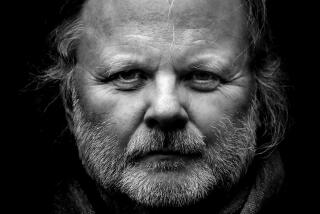Discoveries
- Share via
“People with second sight have known for a long time that some places are more susceptible to spiritual presences than others. Iceland is one of the spheres for this special presence; people knew this even in the Middle Ages. There are special spots here where the All-thought is manifest in the elements themselves, places where fire has become earth, earth become water, water become air, and air become spirit.” So says farmer Helgi of Torflhvalastadir, a member of Pastor Jon’s parish under the glacier at Snaefellsjokull. It is this very parish that the bishop of Iceland sends a rather insipid young man -- referred to in the novel as “the undersigned,” or “the EmBi” (short for “Emissary from the Bishop”) -- to investigate.
“Under the Glacier” was first published in 1968, 13 years after Laxness was awarded the Nobel Prize in literature and 30 years before his death.
“Say and do as little as possible,” the bishop advises. “Keep your eyes peeled.” Two issues in particular trouble the bishop: a rumor that a body has been buried in the glacier and the fact that the pastor seems to have misplaced his wife. The general disrepair of Pastor Jon’s church and the absence of services and burials are also troubling. The EmBi travels to the glacier, finds Pastor Jon (who is adept at fixing Primus stoves and shoeing horses but who doesn’t do much preaching) and begins his investigations in as dry and logical a manner as he can muster. He also speaks with the parish clerk, the parish clerk’s wife and daughter, and the local poet, but all of these interviews bear a close resemblance to the tea party in “Alice’s Adventures in Wonderland,” so the EmBi is easily confused and frustrated. He attempts to take note of the customs of the local inhabitants. (“Luckily it isn’t the custom to eat dried fish off a tablecloth,” Laxness observes. “Dried fish lies to the north of cutlery in space and belongs to the Stone Age, or at least the Middle Ages in time.”)
Pastor Jon describes his theology as an effort “to receive omnipotence from the galaxies.” “When I discovered that history is a fable,” he explains to the EmBi, “and a poor one at that, I started looking for a better fable, and found theology.” He has come to believe that “whoever worships a mountain ... then the mountain is his god; a stone if you adore a stone; a tree trunk if you believe in a tree trunk; and so on.” What god do common Icelanders have, the local poet asks the EmBi, “besides Black Death booze, if it isn’t warm Danish aquavit?”
Laxness rounds out the EmBi’s report with his own druidic observations of Iceland’s landscape and its effect on her inhabitants: “The older woman had that drained, tolerant look that was for a long time the net profit that older country people earned from life’s struggle,” and, “It only adds to the shivers to listen to the bleating of birds on a raw night in early spring.” But in the philosophical discussions of his characters you can almost hear him chuckling. “It’s a pity we don’t whistle at one another, like birds,” Pastor Jon tells the EmBi. “Words are misleading.... I am always trying to forget words. That is why I contemplate the lilies of the field, but in particular the glacier. If one looks at the glacier for long enough, words cease to have any meaning on God’s Earth.”
As for the pastor’s church, most of it, including the pews and the pulpit, was chopped up for firewood during the “spring of great snows.” No sooner does the EmBi believe his investigation finished than three men, the “winter-pasture shepherds,” appear on the glacier. They have come, they tell him, to perform a reanimation of the body in the glacier. The most powerful of the three, Mundi, has a laboratory back in Ojai, Calif.
This would all be much less serious, more pure science fiction, if (1) the characters weren’t Icelanders and (2) if it didn’t concern the failures of Christianity and the reintroduction of paganism. It is difficult to tell when Icelanders are joking, and Laxness is no exception to this rule. His characters live by the Sagas, the weather, and some otherworldly natural force that passed into remission with the coming of electricity but waits in the glacier to return. And we believe him. If the forces of nature lie dormant anywhere, it is easy to believe that Snaefellsjokull Glacier is the place.
More to Read
Sign up for The Wild
We’ll help you find the best places to hike, bike and run, as well as the perfect silent spots for meditation and yoga.
You may occasionally receive promotional content from the Los Angeles Times.






